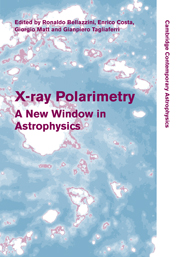Book contents
- Frontmatter
- Contents
- List of contributors
- Preface
- 1 X-ray polarimetry: historical remarks and other considerations
- Part I Polarimetry techniques
- Part II Polarized emission in X-ray sources
- Part III Future missions
- 37 Gravity and Extreme Magnetism SMEX (GEMS)
- 38 Programs of X-ray polarimetry in Italy
- 39 A polarimeter for IXO
- 40 Polarimetry with ASTRO-H soft gamma-ray detector
- 41 The Energetic X-ray Imaging Survey Telescope and its polarization sensitivity
- 42 PoGOLite: a balloon-borne soft gamma-ray polarimeter
- 43 Studies of neutron background rejection in the PoGOLite polarimeter
- 44 Observing polarized X-rays with PoGOLite
- 45 Pre-flight qualification tests of the PoGOLite detector system
- 46 The Gamma-RAy Polarimeter Experiment (GRAPE) balloon payload
- 47 POLAR: an instrument dedicated to GRB polarization measurement
- 48 Polarization detection capability of GRIPS
- 49 X-ray and γ-ray polarimetry small-satellite mission PolariS
- 50 GAP aboard the solar-powered sail mission
- 51 Hard X-ray polarimeter for small-satellite missions
- 52 Performance of hard X-ray polarimeter: PHENEX
- 53 GRB polarimetry with POET
- Author index
- Subject index
37 - Gravity and Extreme Magnetism SMEX (GEMS)
from Part III - Future missions
Published online by Cambridge University Press: 06 July 2010
- Frontmatter
- Contents
- List of contributors
- Preface
- 1 X-ray polarimetry: historical remarks and other considerations
- Part I Polarimetry techniques
- Part II Polarized emission in X-ray sources
- Part III Future missions
- 37 Gravity and Extreme Magnetism SMEX (GEMS)
- 38 Programs of X-ray polarimetry in Italy
- 39 A polarimeter for IXO
- 40 Polarimetry with ASTRO-H soft gamma-ray detector
- 41 The Energetic X-ray Imaging Survey Telescope and its polarization sensitivity
- 42 PoGOLite: a balloon-borne soft gamma-ray polarimeter
- 43 Studies of neutron background rejection in the PoGOLite polarimeter
- 44 Observing polarized X-rays with PoGOLite
- 45 Pre-flight qualification tests of the PoGOLite detector system
- 46 The Gamma-RAy Polarimeter Experiment (GRAPE) balloon payload
- 47 POLAR: an instrument dedicated to GRB polarization measurement
- 48 Polarization detection capability of GRIPS
- 49 X-ray and γ-ray polarimetry small-satellite mission PolariS
- 50 GAP aboard the solar-powered sail mission
- 51 Hard X-ray polarimeter for small-satellite missions
- 52 Performance of hard X-ray polarimeter: PHENEX
- 53 GRB polarimetry with POET
- Author index
- Subject index
Summary
The prime scientific objectives of the NASA Small Explorer mission, Gravity and Extreme Magnetism SMEX, or “GEMS”, are to determine the effects of the spin of black holes, the configurations of the magnetic fields of magnetars, and the structure of the supernova shocks which accelerate cosmic rays. In the cases of both stellar black holes and supermassive black holes, sensitivity to 1% polarization is needed to make diagnostic measurements of the net polarizations predicted for probable disk and corona models. GEMS can reach this goal for several Seyferts and quasars and measure the polarizations of representatives of a variety of other classes of X-ray sources, such as rotation-powered and accretion-powered pulsars. GEMS uses foil mirrors to maximize the collecting area achievable within the SMEX constraints. The polarimeters at the mirror foci are time projection chambers which use the photoelectic effect to measure the polarization of the incident photon. We have built laboratory models with good efficiency and modulation in the 2–10 keV range. An attached small student experiment would add 0.5 keV sensitivity for bright, soft sources. The instrument has a point spread function which allows measurement of structures in the brighter nearby supernova remnants. GEMS' Orbital Sciences spacecraft will rotate at a rate of 0.1 revolutions per minute during observations, so that systematic errors due to the detector can be detected and corrected. A program of 35 sources can be observed in 9 months. […]
- Type
- Chapter
- Information
- X-ray PolarimetryA New Window in Astrophysics, pp. 251 - 259Publisher: Cambridge University PressPrint publication year: 2010
- 15
- Cited by



